Why Does White Marble Turn Yellow?
An elegant white, marble floor makes a sophisticated statement in any home or business. But what happens if your beautiful white marble begins to turn yellow?
Unfortunately, this problem is not uncommon, according to Fred Hueston, Chief Technical Director for Stone and Tile PROS, who says there are a number of causes for yellowing marble—and a number of possible cures.
Iron Oxidation
The most common culprit for white marble turning yellow is iron, which can be found in many natural stones. When exposed to water, acids or bleach, the iron in the stone will begin to oxidize and turn it yellow. In extreme circumstances, the marble can turn a brown color, akin to what happens to a piece of iron left out in the rain. To find out if your marble contains iron, you can have your stone tested by a lab.
Oxidation is accelerated when marble is saturated with water. If you’ve had a pipe burst or excessive water has been used on the marble floor, have your water tested for iron, especially if you’ll be cleaning with it. It’s also a good idea to test the marble for moisture if it has been soaked with water.
If oxidation is indeed your issue, preparing and applying a poultice solution may rid the yellowing from the marble in some cases. There are also some new products that are aimed at removing iron oxidation. Consult with your stone restoration contractor for poultice mixtures or other products that may work best for your situation.
Wear and Tear
Wear and tear can also cause yellowing of white marble. As the polished surface wears away, trapped dirt in the marble’s pores can give the stone a yellow appearance.
Improper Cleaning
Using dirty mops allows dirt to accumulate and remain even after cleaning, resulting in a dingy, yellow looking floor. This type of yellowing may possibly be removed with a professional cleaning with a heavy-duty stone cleaner.
Wax Build-up
When waxes are used on marble, the waxes themselves can build up and turn yellow, leaving your gorgeous white marble looking aged and yellowed. In this case, the floor will need to be stripped to attempt to remove the color.
Crystallization
Some stone floors are polished using the process of crystallization. If your marble contains any moisture when this type of polishing occurs, the stone will begin to yellow. This can sometimes be reversed with a powder marble polish and if not, the floor will need to be honed by your stone and tile care professional.
This is one of a series of articles written and published on behalf of Stone and Tile PRO Partners.



 Google map
Google map Facebook
Facebook